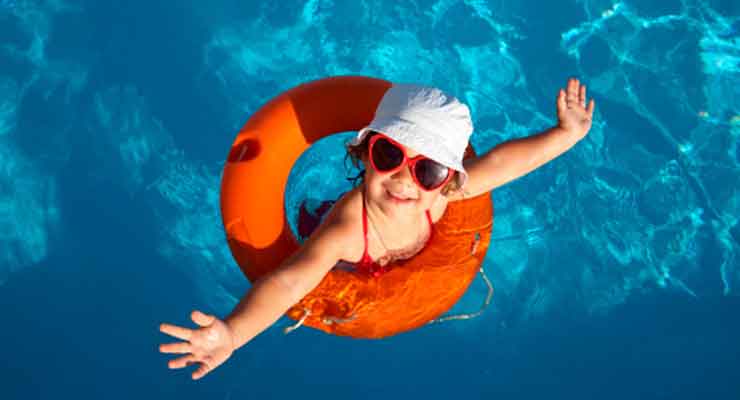Swimming is one of the most popular activities for families to enjoy during the summertime. However, you shouldn’t let the fun lull you into a false sense of security. All too often, we hear about drowning incidents that stem from children swimming unattended or parent inattention.
That’s why it’s so crucial that you make safety a top priority whenever your children are in the water. Here are five things you can do to make sure your child has safe fun this summer:
1. Be vigilant
Always keep an eye your kids; nothing is more important than adult supervision when it comes to keeping kids safe at the pool. Remember, it only takes one second for things to go wrong and a swimmer is trying to yell for help. This means you must rely on your eyes, not your ears, when you are at the pool with your kids. Don’t let yourself be distracted by your phone or the latest gossip in a magazine. It’s definitely easier said than done, but it will make the biggest difference when ensuring your child’s safety.
2. Don’t underestimate security
If you have a pool at home, you can use your home security system to alert you when anyone goes outside, so you will know immediately if your child goes near the pool area. Security companies may install video cameras in the patio or pool area. However, some companies will not because they don’t want the camera to be a substitute for parent’s attention. A proper security system can help you keep tabs on indoor and outdoor activity to protect your children from danger. You may also want to add a fence around the pool area to prevent any accidents from happening.
3. Teach your children pool safety
Before you get to the pool, make sure your kids know the basics of pool safety, such as no running, dunking each other, playing dead, or swimming where nobody can see you. If you have a pool home, it’s not a bad idea to set rules and remind them that using the pool is a privilege and may be taken away if they do not follow them. Make sure they understand that an adult must be present when using their neighbor’s pool.
4. Teach your children to swim
Whether you hire a certified swim instructor for swimming lessons for your children or teach them yourself, swim lessons are essential. Toddlers as young as two or three years old are eligible for lessons, and even children under two can be taught basic survival in a pool. When children are comfortable in the water and knowledgeable about water safety, they will gain greater enjoyment from swimming and you will have greater peace of mind.
5. Do not rely on floating objects
Inner tubes and floaties make for great fun, but having them in the pool with your kids does not negate the need for supervision. Sometimes rafts can pose a threat as a child may get stuck under one, and they would be hard to see. Know where your child is in the pool at all times and teach them how to safely play with pool toys. Life vests are always a great precaution as they hold a child above the water and teach them the proper form for swimming. However they are still not a replacement for adult supervision as a child may flip upside down, and he or she may not be strong enough to get upright again without help.
6. Be aware of the water temperature
If the water is too cold and your child starts to shiver or complain of cramps, it’s time to get him out of the water. While this is less of a concern at public pools because they are usually warmer, it becomes especially vital when you take your family to the lake or river. Also don’t forget that while a cool pool may be refreshing on a hot day, you and your children are still sweating and losing water. Many people forget to properly hydrate when in a pool because they are surrounded by water, so make sure your children are regularly consuming water or beverages high in electrolytes to avoid heat exhaustion and dehydration. Also, bring snacks if they will be swimming for a long period of time, so they can refuel before getting back in the water.
7. Know what to do if something bad happens
If you notice that someone in the pool is in trouble, the first thing you should do is yell for help. While life guards keep a very close eye on what happens in the pool that does not mean that they have noticed what you have. If a lifeguard is present, allow them to perform rescue duties. If you are somewhere where a lifeguard is not present and a child appears to be in distress, jump into the water (with a floatation device if available). If you are in deep water when you reach the child, assure them that you are there to help. Then turn them on their back and hook your arms under their under arms and allow their head to rest on your shoulder. Use your legs to kick back to the side of shallow end of the pool. If you can stand, pull the person above water and help them get to the side of the pool.
In any situation where someone falls on the pool deck, dives in shallow water, or hits their head on the side of pool or diving board when jumping in, spine and neck injuries are a possibility. If they are on solid ground, do not move them until EMT help has arrived. If they are in the pool, take precautions to move their neck and head as little as possible. First aid kits should always be on hand for minor cuts and scrapes.
Children love to swim; sometimes for hours on end, but it can create a headache and anxiety for parents. If you stay alert, make sure your kids know how to swim, teach them safety rules, and have a plan of action in the event of an emergency, the summer will be a happy and safe time for your family.





